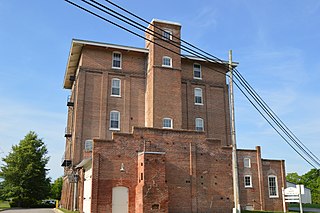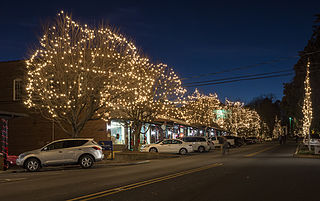
The Cedarock Historical Farm, located at Cedarock Park in Alamance County, North Carolina, provides an example of life on a farm in North Carolina during the 19th Century. Populated with farm animals, antique and replica farm equipment, and a farmhouse, the Historical Farm provides a fun, education stop while visiting Cedarock Park.

Woodside Cotton Mill Village Historic District is a national historic district located in Greenville County, South Carolina. The district encompasses 278 contributing buildings and 2 contributing sites in an early 20th century urban South Carolina textile mill village. Centered on a mill founded by John T. Woodside in 1902, the district is located just west of the city limits of Greenville and is largely intact despite modernizations made by a succession of mill and home owners. The mill itself is a rectangular, brick, four-story building designed by J.E. Sirrine and built between 1902 and 1912. Eventually the mill became the largest cotton mill under one roof in the United States and one of the largest in the world.

Kendall Mill Historic District is a historic mill complex, mill village, and national historic district located at Camden, Kershaw County, South Carolina. The district encompasses 119 contributing buildings, 1 contributing sites, and 1 contributing structure in Camden. The district is centered on the Wateree Plant and associated structures that date from 1899 to 1923. The mill village to the south and southeast of the plant was built between 1900 and ca. 1925 and is a virtually intact reminder of the importance of the textile industry to South Carolina. The mill faces Kendall Park, a ten-acre landscaped park. On the eastern border of the park are the mill supervisors’ houses, built between 1900 and ca. 1925. The operatives house consist of one-story, 1 1/2-story, and a few two-story frame houses which date from 1900 to 1923. The district also includes Kendall Lake, north of the mill. The Dekalb Cotton Mill was organized in 1899. The Dekalb Mill building, designed by W.B. Smith Whaley in the Romanesque Revival style, was considered a model of textile architecture. The original plant building is a four-story rectangular brick building with a back stair tower and an imposing six-story front stair tower. The west addition to the plant, which is in keeping, architecturally, with the older buildings, was constructed in 1964. It is located in the City of Camden Historic District.

Buffalo Mill Historic District is a national historic district located at Buffalo, Union County, South Carolina. The district encompasses 190 contributing buildings and 2 contributing structures associated with the Buffalo Mill textile mill complex and mill village. The mill complex includes the main mill, mill office, power house, ice factory, mill warehouse, company store, and company bank/drug store. The main mill building features applied stylized Romanesque Revival detailing. The mill village housing varies from large, free-classic, Queen Anne style supervisor's houses, to shingle-style bungalows, to simple, one-story, workers residences. The village also includes a school and a baseball field/park.

Glencoe Mill Village Historic District is a national historic district located at Glencoe, Alamance County, North Carolina. It encompasses 48 contributing buildings and 6 contributing structures built between 1880 and 1882 in Glencoe.
Bellemont Mill Village Historic District is a national historic district located at Bellemont, Alamance County, North Carolina. It encompasses 24 contributing buildings built between 1879 and 1880 in Bellemont. The district includes the three-story brick Bellemont Cotton Hill and 23 associated one and two-story frame mill houses.

Riverside Industrial Historic District, also known as Asheville Wholesale District, is a national historic district located at Asheville, Buncombe County, North Carolina. The district encompasses 27 contributing buildings and 1 contributing structure in a predominantly industrial section of Asheville. Notable buildings include the Orpheus and Bertha Keener House, American Feed Milling Company, Italianate style Carolina Coal & Ice Company, Asheville Cotton Mill Cloth Warehouse, Standard Oil Company complex, and Farmers Federation Building.

Mount Pleasant Historic District is a national historic district located at Mount Pleasant, Cabarrus County, North Carolina. The district encompasses 98 contributing buildings and 3 contributing structures in the town of Mount Pleasant. It includes residential, institutional, and commercial buildings in a variety of popular architectural styles including Victorian, Colonial Revival, and Bungalow / American Craftsman. Notable buildings include the Jacob Ludwig House, Kindley Mill Village houses, Saint James Evangelical and Reformed Church, Lutheran Church of the Holy Trinity, Mount Pleasant Milling Company, Kindley Cotton Mill, and Tuscarora Cotton Mill.

Edenton Cotton Mill Historic District is a national historic district located at Edenton, Chowan County, North Carolina. The district encompasses 70 contributing buildings, 1 contributing site, 2 contributing structures, and 1 contributing object in a small mill village. It includes industrial and residential buildings developed between 1899 and 1923. Residential buildings are primarily simple one-story, single-pile, frame dwellings and some examples of the Bungalow / American Craftsman style. Notable non-residential buildings include the Italianate Revival style Edenton Cotton Mill (1899-1916), Edenton Cotton Mill Office, and First Christian Church (1916).
Cooleemee Mill Town Historic District is a national historic district located at Cooleemee, Davie County, North Carolina. The district encompasses 433 contributing buildings, 1 contributing site, and 6 contributing structures on the original Cooleemee Cotton Mill Company property at Cooleemee. It was developed between 1898 and 1967, and includes notable examples of Gothic Revival, American Craftsman, and Colonial Revival style architecture. Notable contributing resources include the mill houses of 12 house types, Cooleemee Cotton Mill complex, Pest House and the company farm, Friendship Baptist Church, North Cooleemee Elementary School (1952), Church of the Good Shepherd (1925), Cooleemee United Methodist Church (1932), First Baptist Church of Cooleemee (1949), Cooleemee Recreation Center Bathhouse (1949), “The Holler,” and “Riverside Park,” also known as “Park Hill.”

Durham Cotton Mills Village Historic District are a set of historic mill village houses and national historic district located at Durham, Durham County, North Carolina. The district encompasses 15 contributing residential buildings built by the Durham Cotton Manufacturing Company. They are 1+1⁄2-story, "story and a jump" gable end frame dwellings dated to the mid-1880s. Twelve of the dwellings have rear one-story, gable-roofed ells.

West Durham Historic District is a national historic district located at Durham, Durham County, North Carolina. The district encompasses 101 contributing buildings in a mixed industrial, commercial, and residential section of Durham. The buildings primarily date after 1892 and include notable examples of Classical Revival, Italianate, and Queen Anne architecture. Located in the district is the separately listed Erwin Cotton Mills Company Mill No. 1 Headquarters Building. Other notable buildings include Erwin Cotton Mills Co. Mill No. 4 (1909–10), Erwin Cotton Mills Co. worker's housing (1910s), Fidelity Bank (1920s), E. K. Powe School (1928), Blacknall Memorial Presbyterian Church (1922), and St. Joseph's Episcopal Church.

McAdenville Historic District is a national historic district located at McAdenville, Gaston County, North Carolina. It encompasses 93 contributing buildings, 2 contributing sites, and 7 contributing structures in the mill village associated with McAden Mills, a cotton mill chartered by the state legislature in 1881. The buildings were built between about 1884 and 1959, and include notable examples of Late Victorian and Italianate architecture. Notable buildings include 15 brick mill worker houses, remnants of McAden Mill No. 1 (1881–82) and McAden Mill No. 2 (1884–85), McAden Mill No. 3 (1906–07), and Pharr Corporate Offices redesigned by Earle Sumner Draper.

Oakdale Cotton Mill Village is a historic textile mill, mill village, and national historic district located at Jamestown, Guilford County, North Carolina, United States. The district encompasses 37 contributing buildings including the Logan Manufacturing Company complex built during the 1880s and 33 frame mill worker houses dated to the early-20th century. The factory complex consists of a three-story rectangular brick office, a one and two-story L-shaped brick factory with a four-story tower and five one-story brick warehouses, a small one-story board-and-batten blacksmith shop, and a polygonal brick smokestack.

Highland Cotton Mills Village Historic District is a historic mill village and national historic district located at High Point, Guilford County, North Carolina. The district encompasses 177 contributing buildings and 1 contributing structure. They include the two mills and the shipping and packing building at the Highland Cotton Mills, the Highland Cotton Mills Office, the Highland Methodist Church and its parsonage, the Johnson Farm House.

Hawkins Avenue Historic District is a national historic district located at Sanford, Lee County, North Carolina. It encompasses 200 contributing buildings and 4 contributing structures in a predominantly residential section of Sanford. The district includes notable examples of Colonial Revival and Queen Anne style architecture, with buildings largely dated between about 1900 to the 1930s. Located in the district is the separately listed Sanford High School, Former. Other notable buildings include the John McIver House (1880s), Duncan E. McIver House (1893), Malcolm D. McNeill House, E.L. Gavin House (1922), First Presbyterian Church of Sanford (1914), First Baptist Church (1925), the former Sanford Cotton Mill complex, and the Liles Bonded Cotton Warehouse.

Laboratory Historic District is a national historic district located at Laboratory, Lincoln County, North Carolina. It encompasses seven contributing buildings and two contributing structures associated with the Laboratory Cotton Mill and its founder and owner, Daniel E. Rhyne. They include the Laboratory Cotton Mill (1887), the Laboratory Cotton Mill Reservoir, the Daniel E. Rhyne House (1894), and the Federal / Greek Revival style Hoke-Rhyne House. The mill closed in the late 1990s.

Coleridge Historic District is a national historic district located at Coleridge, Randolph County, North Carolina. The district encompasses 17 contributing buildings in the Victorian mill village of Coleridge. It includes buildings built between 1882 and the late 1920s and notable examples of Queen Anne and Romanesque Revival architecture. Notable buildings include the Enterprise Cotton Mill complex, the company store, mill office, Bank of Coleridge, and John Caveness House.

Spray Industrial Historic District is a national historic district located at Eden, Rockingham County, North Carolina. It encompasses 70 contributing buildings, 9 contributing structures, and 1 contributing object in an industrial section of the town of Eden. It includes buildings associated with eight textile mill complexes, mill village housing, and seven commercial buildings. Notable contributing resources include the Smith River Dam and Spray Power canal, Morehead Cotton Mill complex, "Superintendent's" House, Imperial Bank and Trust Company (1912), Leaksville Cotton Mills complex, Spray Mercantile Building, Spray Cotton Mills complex, Lily Mill complex, Nantucket Mills complex designed by R. C. Biberstein, American Warehouse Company complex, Rhode Island Mill complex, Phillips-Chatham House, and Spray Woolen Mill complex.
Glen Royall Mill Village Historic District is a historic mill town and national historic district located at Wake Forest, Wake County, North Carolina. The district encompasses 82 contributing buildings and 1 contributing site built between about 1900 and 1949 and located in a residential section of the town of Wake Forest. It includes notable examples of Bungalow / American Craftsman style architecture. Located in the district is the separately listed Royall Cotton Mill Commissary. Other notable buildings include the Royall Cotton Mill (1899-1900), the Powell-White House (1909-1910), and pyramidal cottages, triple-A cottages, and shotgun houses.




















